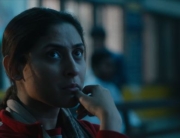Mike Mills’s films are animated not so much by plot as by mood, character, and an accumulation of small, quirky moments. He seems to be motivated by a conviction that meaning can be found in the everyday and the most odd and specific character traits. He is also a big-hearted, sentimental storyteller. This is not necessarily a bad thing. His big heart is his greatest strength, but also his greatest weakness, both of which are on display in his new film, C’mon C’mon.
Joaquin Phoenix plays Johnny, a lonely radio journalist who recently lost his mother; has not been talking much to his sister, Viv (Gaby Hoffmann); and, years ago, suffered a horrible breakup. He goes around the country interviewing young children, asking them their thoughts about the future. These interviews bookend the film and are interspersed throughout, and are delivered by charming, supposedly insightful children from Detroit, New York, and New Orleans.
He ends up going to Los Angeles to see Viv and help out with her eccentric nine-year-old, Jesse (Woody Norman). Jesse loves, among other things, to pretend that he is an orphan, and expects the adults around him to play along. He is also mischievous and buoyant in a way that sharply contrasts with his phlegmatic uncle. His father, Paul (Scooty McNairy), has bipolar disorder and has been in and out of the hospital, and Viv needs to attend to him. None of this has been explained yet to Jesse. It is decided, not without argument, that Johnny will take care of Jesse for this interim period while Viv takes care of Paul in Northern California. Johnny ends up not only watching Jesse in LA but also taking him back to New York, then to New Orleans as he continues interviewing children.
Mills has a history of bringing excellent, even unlikely performances from strong actors (Billy Crudup and Greta Gerwig in 20th Century Women come to mind), and Phoenix is moving to watch in this more sensitive mode. Norman is believable and natural as a young, odd, hyperactive boy, acting out against the pressures in his life that he does not understand by playing games. The film is at its best when it zeroes in on the two of them, how their odd-couple chemistry coaxes one another into new feelings and understanding. Here, Mills’s eye for the odd detail turns poignant, as in a short scene where an exhausted Johnny patiently lets Jessie play with his lower lip. In many scenes, it is hard not to smile, and the film’s sweetness will likely rub off on the viewer at one point or another.
Still, especially here, Mills’s earnest embrace of feelings verges on preciousness, and one has the sense that, in spite of the tragedies which frame the action (mental illness, breakups, death), Mills is keeping pain at an arm’s length. It is not very long before one feels that Johnny and Jessie have a connection, and it actually does not seem so hard for this emotionally broken man to relate to this bouncy child. Though Viv and Johnny have been estranged in recent years, and we also find out why, I often thought it looked like they were doing just fine. Furthermore, the New York City that Johnny and Jessie walk through is an easygoing, friendly place that I barely recognize, where everyone seems cooperative and kind. The worst thing that happens there is that Jessie gets lost for just a minute. None of these streets stink, no one is stressed (except Johnny, and only a little), and no nine-year-old boy is overwhelmed by anything at all, except, occasionally, his feelings.
Also, while watching a Mike Mills film, one often feels a little voice whispering, “Aren’t these people so special? Aren’t they?” This might be implicit, as we watch them in joyous or everyday situations while sentimental music plays, or watch Johnny enlarge his mind by reading books about motherhood (their titles and text are spelled out on the screen), also to musical accompaniment. It might happen more directly, as in a voice-over sequence in which Jessie pays tribute to his mother (this device was used frequently in 20th Century Women).
Then there are the recurring interviews with children. This aspect of the film becomes more baffling as it goes on. These kids, all of them earnest, speak to fears and concerns about the future, though we never feel their fear, and rarely are their thoughts enlightening. The rest of the movie, the one that belongs to Johnny and Jessie, has little to do with fears about humanity writ large, and not much to do with fears about the future in general. By the end, this device comes across as a cloying, hollow gesture toward the wider world that the rest of the film glances away from.
So, C’Mon C’Mon, though enjoyable enough, showcases Mills’s flaws more than anything else. And why exactly did it need to be in black and white? When we get to New Orleans, in particular, one wonders what color could have done to light up the screen.







Leave A Comment